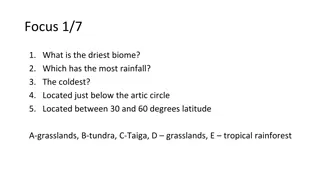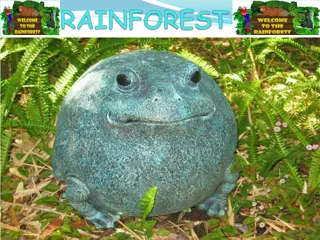Exploring the Fascinating Tropical Rainforest and Its Animals
Tropical rainforests are incredibly diverse ecosystems, home to a wide range of plant and animal species. Discover the beauty of the Tambopata National Reserve and learn about amazing animals like macaws, bonobos, felines, and more that inhabit these lush environments. Explore the significance of rainforests in housing a multitude of species and the unique characteristics of the bonobo, including its diet and habitat in the Congo basin of Africa.
Download Presentation

Please find below an Image/Link to download the presentation.
The content on the website is provided AS IS for your information and personal use only. It may not be sold, licensed, or shared on other websites without obtaining consent from the author. Download presentation by click this link. If you encounter any issues during the download, it is possible that the publisher has removed the file from their server.
E N D
Presentation Transcript
THE BIOLOGY PROJECT( TROPICAL RAIN FOREST AND ITS ANIMALS) FROM RAMEZ, SANAD, AOUN, BISHARA
THE ANIMALS The macaws. In the Tambopata National Reserve, you find the 3 largest and most colorful. Animals to talk about: bonobo, bongo, forest elephant, poison dart frog Monkeys (8 species in this area of Madre de Dios in Peru) Felines such as the jaguar, the puma, and the ocelot Very famous fish like piranhas (not necessarily as aggressive as in the movies, at least not in the whole Amazon) Pink dolphins (north of the Peruvian Amazon) among others.
WHAT IS A RAINFOREST Tropical forests are some of the richest, most exciting areas on earth. They are home to gigantic trees, colorful birds and a huge variety of fascinating mammals. About 80% of the world's documented species can be found in tropical rainforests, even though they cover only about 6% of the Earth's land surface - less than half the area they covered not so very long ago. (they have a high biodiversity). This Photo by Unknown Author is licensed under CC BY-SA
WHAT IS A BONOBO The bonobo lives in Africa in the Congo basin in Africa. It lives in between 30 to 80 individuals. The bonobo is an omnivore. Also, bonobos are very intelligent, because one of these individuals was caught understanding more than 3000 words. This Photo by Unknown Author is licensed under CC BY-SA
WHAT IS THE SIZE OF BONOBO Size: bonobos are not that small, male bonobos weigh about 39kg, female bonobos weigh about 31kg, both male and females have a standing height of 115cm. Also, bonobos have smaller heads and smaller ears.
WHAT DOES THE BONOBO EAT Food: bonobos have a supplement of large fruit, have diet of seed based with insects and they Eat rodents which are animals. Bonobos also mainly eat leaves, stems, fruits, worms, insects, and sometimes small fish.
WHERE DOES HE LIVE Location: Bonobos are found only in a small part of one country in Africa, the Democratic Republic of Congo. The four subspecies of chimpanzee range from western to central Africa.
WHY IS HE ENDANGERED Reasons behind danger: The bonobo monkey is currently endangered due to destruction and habitat loss. Bonobos are also decreasing rapidly because of hunting, not only by humans, but by other wild animals.
WHAT IS BEING DONE NOW TO THE BONOBO BCI has trained and equipped over 200 trackers and Eco guards, providing protection for bonobos and economic opportunity for local residents.
STATISTIC OF BONOBO Statistic: 29,500 to 50,000 individuals
WHAT IS A BONGO The bongo is a large forest antelope that lives in the tropical jungles of Central Africa. One of the world s most distinctive antelopes, the bongo has a bright, chestnut-brown coat with vertical white stripes. With a shoulder height of up to 1.3 m / 4.3 ft, the bongo is the world s third- largest antelope. Bongo have large ears with excellent hearing. Its pointed, spiral horns can grow up to a meter (3.28 ft.) in length. Both males and females have horns. This Photo by Unknown Author is licensed under CC BY-NC
WHAT IS THE SIZE OF BONGO Size-Bongo antelope Weigh between 500 and 600 pounds and stand about five feet tall at the shoulder.
WHAT DO THE BONGO Bongos are herbivore animals that primarily feeds on foliage of all types, including young shoots and leaves. Bongos will also consume good amounts of fruit when it is available.
WHERE ARE THE BONGO LOCATED Where Are they Located-They live in the tropical jungles of Central Africa.
WHY ARE THEY ENDANGERED Why are they Endangered: Due human activities by threatening them.
STATISTIC OF BONGO 150 bongo left in the wild
WHAT IS BEING DONE NOW TO THE BONGO, SO IT DOESN T BE EXTINCT large swaths of land that bongos can use to roam freely and safely from one park, or country, to another. Corridors link protected areas and allow wildlife to follow rains or travel to their calving grounds without disturbing human settlements.
FOREST ELEPHANT The forest elephant (also known as the African forest elephant) is one of two elephant species found in Africa: the other is the larger African bush elephant. Until recently, both African elephants were the same species. The forest elephant is the smallest of the three species of elephant. (The third elephant species, the Asian elephant, is found in Asia.) The forest elephant is found in the jungles of West and Central Africa south of the Sahara Desert. The species is critically endangered. It is threatened by habitat loss, poaching for its ivory, and being hunted for food. Statistic: 40,000-50,000 left in the wild
WHAT IS BEING DONE NOW TO THE FOREST ELEPHANT, SO IT DOESN T BE EXTINCT To get there, we employ five major strategies: Prevent illegal killing. Protect elephant habitat. Monitor elephant numbers, poaching rates, and threats to elephant habitat at key sites in Africa and Asia.
POISON DART FROG Many other frog species camouflage themselves in the wild, but the poison dart frog uses its brightly colored skin to warn predators that it is unfit to eat. The frog's skin causes a dangerous poison that can paralyze and even kill predators. There are more than 100 species of poison dart frogs, including those that live in the Amazon.
WHAT IS BEING DONE NOW TO HELP POISON DART FROG Wild poison dart frogs are protected by treaty, but that increases their value to smugglers, who export them illegally to capitalize on the demand. Smugglers hide these little frogs in concealed in legal shipments of exported tropical fish.
GLOSSARY Antelope: a swift-running deerlike ruminant with smooth hair and upward-pointing horns, of a group native to Africa and Asia that includes the gazelles, impala, gnus, and elands. Poaching: illegally hunt or catch























